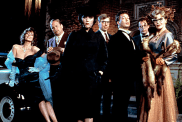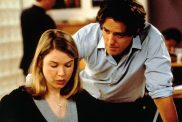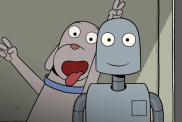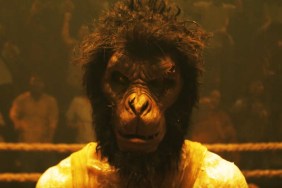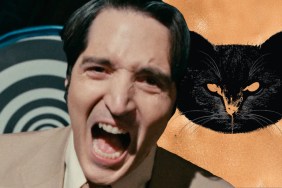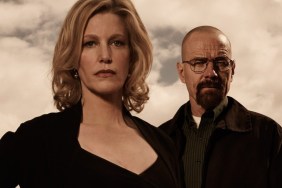
After watching your OSS films this weekend and with The Arist, your ability to capture a time period is fantastic. How do you approach the design for your films?
MH: It’s my third period movie, and thank you for saying that. When people usually do a period movie they recreate what they are shooting — the costumes, location, haircuts, etc. — but they don’t really care about the way they shoot it. They shoot it in modern fashion. I can’t believe what I’m seeing if I see an actor from the ’20s shot with a Steadicam. I can’t believe it.
So, the idea was to also recreate the shooting process, not just what we were shooting, but how we shot it. We didn’t use old cameras or anything, but we respected [the time period with] simple shots. I tried to work in the American spirit of that time and I think that really helps for the recreation of the period.
For example, you can’t imagine a nude sequence in a black-and-white silent movie. That would be hilarious so you can’t do that. You have to think of the way they did it. Also, I don’t try and prove anything. If you have a good actor and he’s telling the story, you don’t have to prove you’re in the ’20s in every shot. Just a white wall or a tree is enough. A tree can be in the ’20s, you don’t have to put in all the cars and everything else to do it.
I was reading through a lot of your interviews and several people have asked you what films influenced you when making this movie and I have to be honest, I don’t think you’ve ever really answered the question. But there had to be some influences. For example, the dog conjures comparisons to The Thin Man, there’s Sunset Blvd. and what about Jacques Tati?

MH: I have a strange relationship [with Tati]. Tati, for me, should belong to the modern art museum more than the movie business. Jour de fete or Mon Oncle are easy to watch and very entertaining, but Trafic or Playtime, to me, you have wonderful ideas but to watch as a movie, I’m not sure if I should say this, but it’s a little bit boring. It’s a little bit too long.
I can agree with you when you look at the first half of Playtime, but I think the second half is amazing and really funny.
MH: Yeah, but if you take every sequence and you put it in a modern art museum it’s genius. It’s genius. I mean, the execution of the ideas, the way the world is transcended by the most simple ideas is absolutely wonderful, but to sit in the theater for two hours is, to me, a little bit too much. I totally respect him, but if you compare [Tati] to Charlie Chaplin, for example, Charlie Chaplin is just — I mean — I — the story, the characters, it’s everything you have in Tati, but in a way it respects the medium, respects the spectators. Basically it’s so easy when you have a story for the spectator.
The way I see things, you want to be entertained, and Chaplin does that. Tati, not always.
As for the references, people are crazy with the references. They see things that I didn’t really [intend]. There are a lot of references and there are a lot of [homages]. The breakfast sequence comes from Citizen Kane, there’s Sunset Blvd., there’s 7th Heaven by Frank Borzage, there’s some things I took from Murnau, but sometimes it’s very hidden and you can’t even see it because it’s not exactly the same thing.
There is one thing, and I’m not exactly sure you will believe me, but I have never seen The Thin Man.
Oh really?
MH: No, really.
You have to see the movie now. You have to.

MH: No, I’ve never seen it. But when we were shooting [The Artist] the makeup artist, Julie Hewett, gave me the DVD. Because she talked to me about The Thin Man and I said, “I don’t even know the movie.” So she offered the DVD, but I still haven’t…
You still haven’t watched it?
MH: No. [laughing]
You have got to watch it. It’s a great film first of all, and maybe it will help in a later interview and you can say, “I finally watched The Thin Man.” Because what you did with the dog in The Artist is right there with it.
MH: Yeah, I thought the dog [in The Artist] was so period. To have a character with a dog, it’s something that helped recreate the period and it’s not about the technical or finding a good location. It’s just a dog, a Jack Russell.

It’s also a good emotional connector for the audience.
MH: Yeah, and it helps a lot for the story. Some very simple things like George has a wife at the beginning of the movie and at the end he has another wife and for some people that can be very antipathic. And the character is very proud and refuses to go to the talkies. To me he has a lot of bad characterizations, but I think you forgive a character of a lot of things if he is beloved by a dog.
Because an animal knows. They know who is a good person because they have the instinct. So in a way that helps a lot and when you write a character you need another character around him to help characterize him, and I didn’t do it knowing I was doing that. But it’s funny, George’s only friend who doesn’t leave him in the movie is a character that doesn’t speak at all. It’s a dog and it’s deeper than I thought. He really has to be there. At the end of the day I think he has a crucial function in the movie.
I can’t leave without asking you what you’re working on next and will we see a third OSS film?
MH: The best compliment I think I had coming out of The Artist was from John Goodman who said, “Watching that movie was like watching a beautiful watch. It’s very simple, it gives the hour, but inside it’s very, very complex.” And the one thing I learned was it’s very complex to make things look simple.
So the next one I want to do something simpler, a very simple story. So I think it’s going to be more human, more emotional and have a political context. I can’t write, unfortunately, right now because I am promoting the movie and working with the Weinstein Co. is a lot of work. It’s not them, but to promote the movie it’s a lot of work. So I can’t really write. I need to go to the office from 9 AM to 7 PM, every day, that’s the way I have to work.
For the OSS, I don’t know, maybe. It’s really simple the way I work. I have to desire the movie and now I have stronger desire elsewhere. But I love the character and I love working with Jean.
The Artist hits theaters on November 25. You can read my review from the Cannes Film Festival click here.
